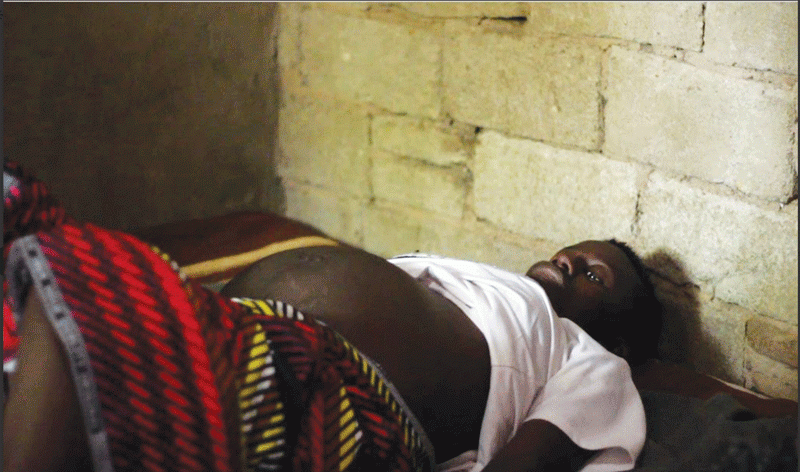
THIS is the second part of a series: “The high cost of motherhood: A silent maternal health care epidemic in Zimbabwe” supported by the International Women’s Media Foundation’s Howard G Buffett Fund for Women Journalists.
It was on a Sunday afternoon in 2018 when Kudzai Matanga spent almost three hours at a bus stop failing to get transport from Arcturus to the Mabvuku clinic in Harare metropolitan province.
Matanga (35) who lives in Arcturus, a small mining village in the Mashonaland East province, about 32 km east of Harare was experiencing labour pains.
She went to the bus stop to get a ride to Mabvuku clinic, one of the local health facilities which is about 11 km from where she stays to access maternal healthcare service.
“I got to a bus stop which is about two and a half kilometres from my house at around 3pm. I sat there seeking for a ride from motorists passing by, but no one paid heed.”
“When I saw that it was getting late, despite intense labour pains, I slowly walked back home praying for strength and courage considering the situation that I was in.”
“I could feel that the baby was close,” Matanga told NewsDay.
She had decided to go back home to see if she could manage to deliver her baby alone.
- Guard fires shot at Artuz boss
- High cost of motherhood: A silent maternal health care epidemic in Zim
Keep Reading
When she reached home, Matanga improvised a makeshift bed on the floor making arrangements for her baby to come and this was something that she was going to do alone with no medical assistance available.
“I was so terrified because I did not know what was going to happen to me and the baby. But I had to soldier on,” Matanga said.
Around 8pm the labour pains increased and after a while, Matanga gave birth to a healthy baby boy. She quickly wrapped the baby in a blanket to keep him warm.
“I then used a razor blade to cut the umbilical code and tied it with a thread. It was scary, but I had to do it to save my child.
“I cradled my baby and breastfed him. I was so tired that I could not clean the floor after giving birth. We spent the entire night sleeping in the pool of blood. Our neighbours never realised that I had given birth alone at home considering that I had returned home after dark,” Matanga said.
A sad reality
Home births like Matanga’s are common in rural areas where houses are far apart and this situation puts both mothers and new-borns at risk.
The United Nations Population Fund (UNFPA) reports that in most rural setups, pregnant women have to go and stay at the health institution weeks before delivery to ensure that they experience labour under the care of skilled health providers. About two thirds (66%, ZDHS 2010/11) of births are assisted by a skilled provider (doctor, nurse-midwife or nurse) which is a decrease of 2% from 68%
“Thirteen percent of births are assisted by a traditional birth attendant and another 13% by untrained relatives or friends and 3% are unassisted.
About two thirds (65%) of Zimbabwean births occur in health facilities, primarily in public sector facilities. Home births are three times more common in rural areas (42%) than in urban areas,” revealed UNFPA.
Amnesty International campaigns coordinator, Roselina Muzerengi said policies guiding maternal health in Zimbabwe emphasise the importance of access to maternal healthcare and primary health services.
“However, implementation of these policies remains a challenge, especially in rural areas where pregnant mothers have to walk for hours to reach clinics. Health facilities in most cases are far away from and people are exposed to risks of giving birth on the road or at home like Matanga,” Muzerengi said.
In Zimbabwe, access to healthcare remains a critical issue, particularly for rural communities. Many people live far from formal health facilities, making it difficult to seek medical attention promptly.
The scarcity of health centres, clinics and hospitals exacerbates this problem and the vast distances between villages and health institutions pose significant barriers.
Just like Matanga, residents often have to walk long distances or rely on unreliable public transportation to reach the nearest clinic or hospital.
The situation presents a multi-layer of problems to mothers since it would be difficult to acquire documentation of babies born at home.
Even though Matanga took her baby to the clinic for the BCG vaccine for tuberculosis, she could not get a birth record and a baby card.
Until now the little boy, now six years old, does not have a birth certificate.
According to the Health and Child Care ministry, Health Expenditure Tracking in Zimbabwe report, the health sector has been facing a financial crisis due to inflation, especially on domestic funding.
One of the key priorities for policy, planning and administration of the government is having an ongoing investment at the primary care level, constructing health posts to service the needs of poor and hard-to-reach populations.
However, the growing funding gap over the years limited the ability of public health funders to implement health interventions that can promote access to the basic primary health care level.
Per capita, Government of Zimbabwe’s health expenditure has been decreasing from US$51,12 in 2018 to US$8,67 in 2019 and a slight increase to US$11,07 in 2020.
In addition, Zimbabwe has at least 1 850 primary healthcare facilities available in Zimbabwe, but access to these facilities can be further impeded by a lack of infrastructure, such as unmaintained roads, resulting in poor road conditions and potholes creating barriers to transport.
The World Health Organisation revealed that due to financial difficulties, Zimbabwe's bridges that have collapsed from rain are not being repaired, which makes it difficult for patients to travel during emergencies and delays the timely supply of medical supplies and medications to remote health centres.
Government intervention
In 2023, the Zimbabwean government established the Health Resilience Fund (HRF), a donor funded vehicle that pools resources and aims to hasten the country’s transition to universal health coverage.
To facilitate better partnerships and a co-ordinated response to Zimbabwe's health challenges, the fund was introduced along with the National Health Strategy (NHS) 2021–2025, the NHS Investment Case and the National Health Sector Co-ordination Framework.
HRF will allocate over US$90 million towards three key areas of health: Eradicating avoidable deaths of mothers, new-borns, children, and adolescents; bolstering health systems and promoting global health security.
It is unclear, nevertheless, if Zimbabwe would be able to accomplish this given that it has been unable to reach the Abuja Declaration of 2001's minimum 15% annual health budget allocation requirement.











